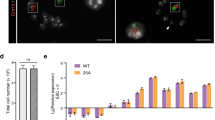Abstract
A 60-Mb murine chromosome consisting of murine pericentric satellite DNA and two bands of integrated marker and reporter genes has been generated de novo in a rodent/human hybrid cell line (mM2C1). This prototype mammalian artificial chromosome platform carries a normal centromere, and the expression of its β-galactosidase reporter gene has remained stable under selection for over 25 months. The novel chromosome was transferred by a modified microcell fusion method to mouse [L-M(TK−)], bovine (P46) and human (EJ30) cell lines. In all cases, the chromosome remained structurally and functionally intact under selection for periods exceeding 3 months from the time of transfer into the new host. In addition, the chromosome was retained in three first- generation tumours when L-M(TK−) cells containing the chromosome were xenografted in severe combined immunodeficiency mice. These data support that a murine satellite DNA-based artificial chromosome can be used as a functional mammalian artificial chromosome and can be maintained in vivo and in cells of heterologous species in vitro.
Similar content being viewed by others
References
Brown WR (1992) Mammalian artificial chromosomes. Curr Opin Genet Dev 2: 479-486.
Brown W, Heller R, Loupart ML, Shen MH, Chand A (1996) Mammalian artificial chromosomes. Curr Opin Genet Dev 6: 281-288.
Calos MP (1996) The potential of extrachromosomeal replicating vectors for gene therapy. Trends Genet 12: 463-466.
Carine K, Solus J, Waltzer E, Manch-Citron J, Hamkalo BA, Scheffler IE (1986) Chinese hamster cells with a minichromosome containing the centromere region of human chromosome 1. Somat Cell Mol Genet 12: 479-491.
Carine (1989)
de Jong G, Telenius AH, Telenius H, Perez CP, Drayer JI, Handlaczky G (1998) Mammalian artificial chromosome pilot production facility: large-scale isolation of functional satellite DNA-based artificial chromosomes. Cytometry (in press).
Dieken ES, Epner EM, Fiering S, Fournier RE, Groudine M (1996) Efficient modification of human chromosomal alleles using recombination-proficient chicken/human microcell hybrids. Nature Genet 12: 174-182.
Fabb SA, Davies AF, Correa I et al. (1997) Generation of novel human MHC class II mutant a-cell lines by integrating YAC DNA into a cell line homozygously deleted for the MHC class II region. Hum Mol Genet 6: 1295-1304.
Farr CJ, Bayne RA, Kipling D, Mills W, Critcher R, Cooke HJ (1995) Generation of a human X-derived minichromosome using telomere-associated chromosome fragmentation. EMBO J 14: 5444-5454.
Harnden DG, Klinger HP (1985) ISCN 1985: An International System for Human Cytogenetic Nomenclature. Basle: S Karger AG.
Harrington JJ, Van Bokkelen G, Mays RW, Gustashaw K, Willard HF (1997) Formation of de novo centromeres and construction of first-generation human artificial microchromosomes. Nature Genet 15: 345-355.
Hay R, Caputo J, Chen TR, Macy M, McClintock P, Reid Y (eds) (1994) ATCC Cell lines and Hybridomas, 8th edn. Rockville, MD: American Type Culture Collection, p 3.
Heller R, Brown KE, Burgtorf C, Brown WR (1996) Mini-chromosomes derived from the human Y chromosome by telomere directed chromosome breakage. Proc Natl Acad Sci USA 93: 7125-7130.
Hollo G, Kereso J, Praznovszky T et al. (1996) Evidence for a megareplicon covering megabases of centromeric chromosome segments. Chrom Res 4: 240-247.
Huxley, C (1997) Mammalian artificial chromosomes and chromosome transgenics. Trends Genet 13: 345-347.
Ikeno M, Grimes B, Okazaki T et al. (1998) Construction of YAC-based mammalian artificial chromosomes. Nature Biotechnol 16: 431-439.
Keresö J, Praznovszky T, Cserpan I et al. (1996) De novo chromosome formations by large-scale amplification of the centromeric region of mouse chromosomes. Chrom Res 4: 226-239.
Mendez MJ, Green LL, Corvalan JR et al. (1997) Functional transplant of megabase human immunoglobulin loci recapitulates human antibody response in mice. Nature Genet 15: 146-156.
Orkin S, Motulsky A. (1995) Report and recommendations of the panel to assess the NIH investment in research on gene therapy. National Institutes of Health. Bethesda, MD, pp 1-28.
Pinkel D, Straume T, Gray JW (1986) Cytogenetic analysis using quantitative, high-sensitivity, fluorescence hybridization. Proc Natl Acad Sci USA 83: 2934-2938.
Simpson K, McGuigan A, Huxley C (1996) Stable episomal maintenance of yeast artificial chromosomes in human cells. Mol Cell Biol 16: 5117-5126.
Smith DJ, Rubin EM (1997) Functional screening and complex traits: human 21q22.2 sequences affecting learning in mice. Hum Mol Genet 6: 1729-1733.
Stubblefield E, Pershouse M (1992) Direct formation of microcells from mitotic cells for use in chromosome transfer. Somat Cell Mol Genet 18: 485-491.
Sun T-Q, Fenstermacher D, Vos J-M (1994) Human artificial episomal chromosomes for cloning large DNA in human cells. Nature Genet 8: 33-41.
Tomizuka K, Yoshida H, Uejima H et al. (1997) Functional expression and germline transmission of a human chromosome fragment in chimaeric mice. Nature Genet 16: 133-143.
Vos J-M (1997) The simplicity of complex MACs. Nature Biotech 15: 1257-1259.
Vos J-M (1998) Mammalian artificial chromosomes as tools for gene therapy. Curr Opin Genet Dev 8: 351-359.
Willard HF (1996) Chromosome manipulation: a systematic approach toward understanding human chromosome structure and function. Proc Natl Acad Sci USA 93: 6847-6850.
Author information
Authors and Affiliations
Rights and permissions
About this article
Cite this article
Telenius, H., Szeles, A., Keresö, J. et al. Stability of a Functional Murine Satellite DNA-based Artificial Chromosome Across Mammalian Species. Chromosome Res 7, 3–7 (1999). https://doi.org/10.1023/A:1009215026001
Issue Date:
DOI: https://doi.org/10.1023/A:1009215026001




